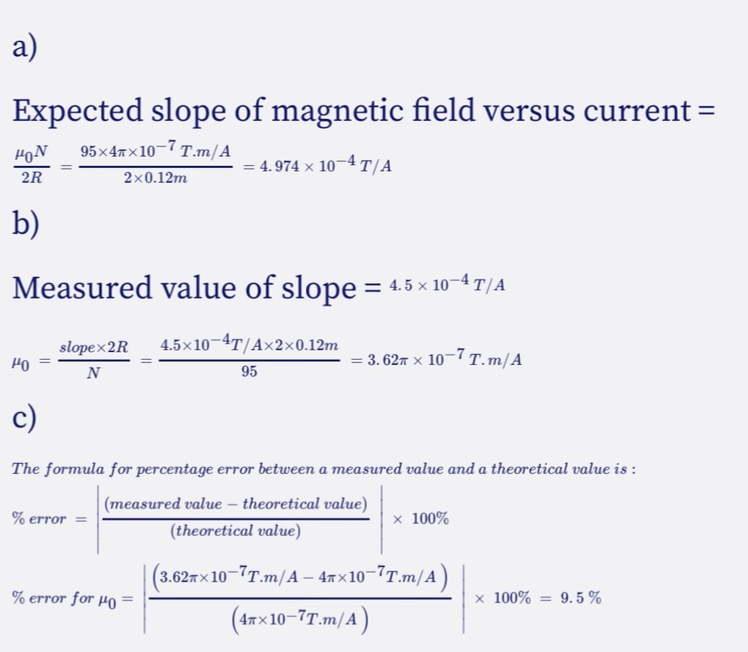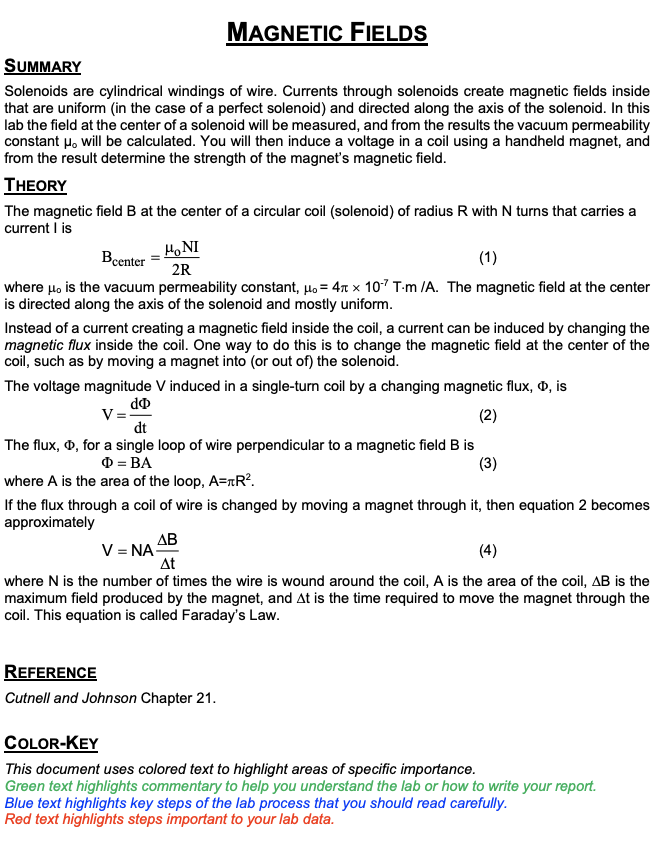She then uses a permanent magnet of strength B = 0.5 mT to induce a voltage in the (same) coil. Calculate the expected voltage if she pulls the magnet from the coil in 0.03 seconds.
She then uses a permanent magnet of strength B = 0.5 mT to induce a voltage in the (same) coil. Calculate the expected voltage if she pulls the magnet from the coil in 0.03 seconds.
Principles of Physics: A Calculus-Based Text
5th Edition
ISBN:9781133104261
Author:Raymond A. Serway, John W. Jewett
Publisher:Raymond A. Serway, John W. Jewett
Chapter23: Faraday’s Law And Inductance
Section: Chapter Questions
Problem 25P
Related questions
Question
She then uses a permanent magnet of strength B = 0.5 mT to induce a voltage in the (same) coil.
Calculate the expected voltage if she pulls the magnet from the coil in 0.03 seconds.

Transcribed Image Text:a)
Expected slope of magnetic field versus current =
95x4x10-7 T.m/A
4.974 x 10-4 T/A
HON
2R
b)
Measured value of slope = 4.5 × 10−4 T/A
slopex2R 4.5×10 4T/A×2×0.12m
N
95
HO
2x0.12m
% error =
c)
The formula for percentage error between a measured value and a theoretical value is :
(measured value - theoretical value)
(theoretical value)
= 3.62″ × 10−7 T.m/A
% error for Ho=
x 100%
(3.62ñ×10¯7T.m/A — 4ñ×10¯7T.m/A)
(47x10-7T.m/A)
x 100% = 9.5%

Transcribed Image Text:MAGNETIC FIELDS
SUMMARY
Solenoids are cylindrical windings of wire. Currents through solenoids create magnetic fields inside
that are uniform (in the case of a perfect solenoid) and directed along the axis of the solenoid. In this
lab the field at the center of a solenoid will be measured, and from the results the vacuum permeability
constant μ, will be calculated. You will then induce a voltage in a coil using a handheld magnet, and
from the result determine the strength of the magnet's magnetic field.
THEORY
The magnetic field B at the center of a circular coil (solenoid) of radius R with N turns that carries a
current I is
Bcenter
Ho NI
2R
(1)
where μ, is the vacuum permeability constant, μ = 4 x 10-7 T-m /A. The magnetic field at the center
is directed along the axis of the solenoid and mostly uniform.
Instead of a current creating a magnetic field inside the coil, a current can be induced by changing the
magnetic flux inside the coil. One way to do this is to change the magnetic field at the center of the
coil, such as by moving a magnet into (or out of) the solenoid.
The voltage magnitude V induced in a single-turn coil by a changing magnetic flux, , is
V=-
(2)
do
dt
The flux, Þ, for a single loop of wire perpendicular to a magnetic field B is
= BA
(3)
where A is the area of the loop, A=TR².
If the flux through a coil of wire is changed by moving a magnet through it, then equation 2 becomes
approximately
AB
V = NA
At
(4)
where N is the number of times the wire is wound around the coil, A is the area of the coil, AB is the
maximum field produced by the magnet, and At is the time required to move the magnet through the
coil. This equation is called Faraday's Law.
REFERENCE
Cutnell and Johnson Chapter 21.
COLOR-KEY
This document uses colored text to highlight areas of specific importance.
Green text highlights commentary to help you understand the lab or how to write your report.
Blue text highlights key steps of the lab process that you should read carefully.
Red text highlights steps important to your lab data.
Expert Solution
This question has been solved!
Explore an expertly crafted, step-by-step solution for a thorough understanding of key concepts.
This is a popular solution!
Trending now
This is a popular solution!
Step by step
Solved in 2 steps with 2 images

Knowledge Booster
Learn more about
Need a deep-dive on the concept behind this application? Look no further. Learn more about this topic, physics and related others by exploring similar questions and additional content below.Recommended textbooks for you

Principles of Physics: A Calculus-Based Text
Physics
ISBN:
9781133104261
Author:
Raymond A. Serway, John W. Jewett
Publisher:
Cengage Learning


Physics for Scientists and Engineers: Foundations…
Physics
ISBN:
9781133939146
Author:
Katz, Debora M.
Publisher:
Cengage Learning

Principles of Physics: A Calculus-Based Text
Physics
ISBN:
9781133104261
Author:
Raymond A. Serway, John W. Jewett
Publisher:
Cengage Learning


Physics for Scientists and Engineers: Foundations…
Physics
ISBN:
9781133939146
Author:
Katz, Debora M.
Publisher:
Cengage Learning

Physics for Scientists and Engineers with Modern …
Physics
ISBN:
9781337553292
Author:
Raymond A. Serway, John W. Jewett
Publisher:
Cengage Learning

Glencoe Physics: Principles and Problems, Student…
Physics
ISBN:
9780078807213
Author:
Paul W. Zitzewitz
Publisher:
Glencoe/McGraw-Hill